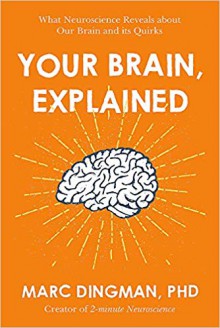
TITLE: Your Brain, Explained: What Neuroscience Reveals About Your Brain and Its Quirks
AUTHOR: Marc Dingman
EXPECTED PUBLICATION DATE: 19 September 2019
FORMAT: Paperback
ISBN-13: 9781473696556
_______________________
NOTE: I received a copy of this book from NetGalley. This review is my honest opinion of the book.
_______________________
DESCRIPTION:
"Sleep. Memory. Pleasure. Fear. Language. We experience these things every day, but how do our brains create them?
Your Brain, Explained is a personal tour around your gray matter. Neuroscientist Marc Dingman gives you a crash course in how your brain works and explains the latest research on the brain functions that affect you on a daily basis.
You'll also discover what happens when the brain doesn't work the way it should, causing problems such as insomnia, ADHD, depression or addiction. You’ll learn how neuroscience is working to fix these problems, and how you can build up your defenses against the most common faults of the mind.
Along the way you'll find out:
· Why brain training games don't prevent dementia
· What it's like to remember every day of your life as if it were yesterday
· Which popular psychiatric drug was created from German rocket fuel
· What triggers sleep loss or lapses in concentration
Drawing on the author's popular YouTube series, 2-minute Neuroscience, this is a friendly, engaging introduction to the human brain and its quirks from the perspective of a neuroscientist - using real-life examples and the author's own eye-opening illustrations. Your brain is yours to discover!"
________________________
REVIEW:
Dingman has written a book that introduces the current state of neurosciene and what we know about the brain to readers that have no science or neuroscience background. The book is divided into ten chapters that cover a different function of the brain: fear; memory; sleep; language; sadness; movement; vision; pleasure; pain; and attention. Each chapter includes case studies, a brief summary of the function and specific area of the brain involved in that function and how that function was determined (i.e. experimental results), and a brief discussion of what happens when things go wrong in that section of the brain (e.g. Alzheimer's disease). The writing style is straight-forward with minimal technical jargon, which is explained and illustrated where necessary. The subject matter is interesting. However, I felt the book was somewhat dull (and rather superficial) and didn't convey the excitement the author felt about the subject.
NOTE: As a bonus, Dingman has a Youtube series (2-Minute Neuroscience) for additional information.

 Log in with Facebook
Log in with Facebook 
















